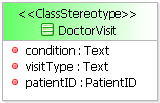UML Profiles and Stereotypes
A UML profile enables you to specify stereotypes. Stereotypes provide a method of extending your business object model.
You may have a particular domain within your business that you want to include in your business object model. You can have a UML profile that enables you to create new model elements, derived from your existing model elements but that have specific properties for your business domain. The UML profile enables you to tailor the language in your business object model to your specific business domain.
If you are using your UML model in a database for example, you may want to specify which database table a Class should be stored in. You can have a UML profile that contains the database tablenames as stereotypes. Once you have created your UML profile you can apply it to your business object model and then apply those Stereotypes to your Classes as required.
Stereotypes can be applied to all business objects in a business object model, including packages, classes, attributes, primitive types, operations, generalizations and associations.
A stereotype is displayed as a name enclosed by guillemets and placed above the name of another business object, as shown below:
You can apply existing UML profiles that have been created elsewhere to your business object model.
You can apply as many profiles as you like to your business object model.
Refer to the following Eclipse documentation for a description of how to create UML2 profiles and define stereotypes.
http://www.eclipse.org/modeling/mdt/uml2/docs/articles/Introduction_to_UML2_Profiles/article.html

